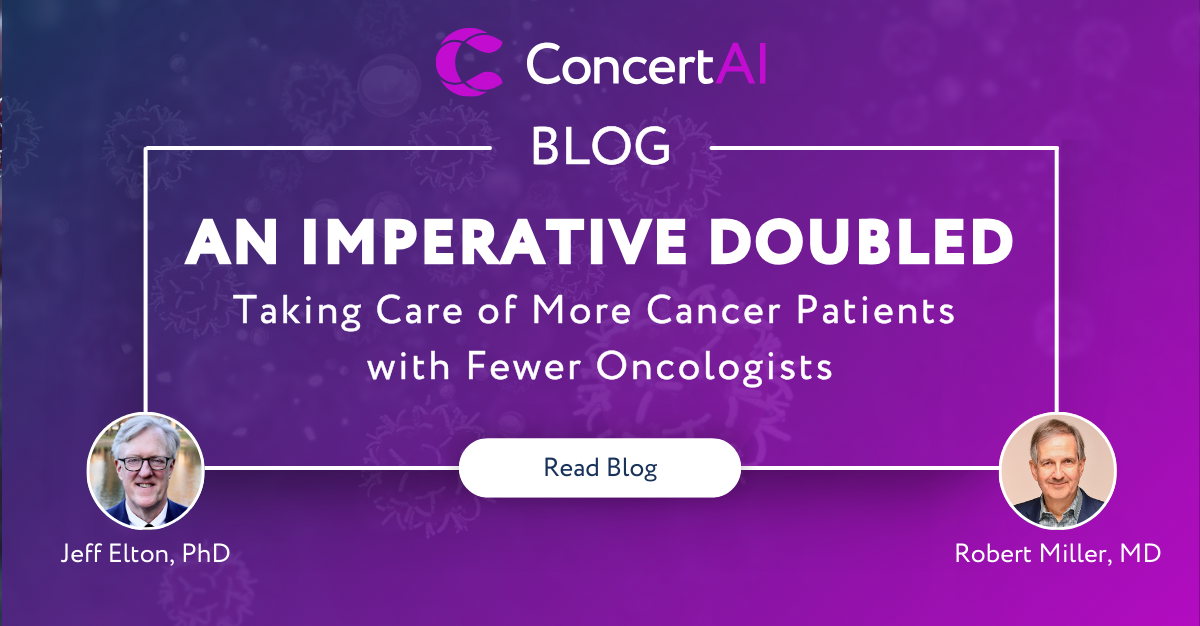
Jeff Elton, PhD; Elizabeth Sweeney, PhD; Nathalie Horowicz-Mehler, PhD, and Catherine Richards, PhD
In a perspective piece from November 2021, we noted that rates of new diagnoses in various solid tumor cancers and hematological malignancies had declined from late 2019 through 2020. We noted that “Cancer patients were disproportionately negatively affected by the COVID-19 virus, especially those with hematological malignancies.”[i] Now, in 2022, it appears diagnosis rates are approaching their pre-COVID levels. Still, cancer persisted during the pandemic, yet due to delayed diagnoses, it was not treated as early as it normally would have been for hundreds of thousands of patients. We know that earlier access to treatment leads to substantially improved outcomes and, due to the large volume of patients with delayed diagnoses, we expect to see an increase in poorer outcomes from 2022 to 2024.
Therefore, we will need to take a two-pronged approach to diagnosis and treatment selection – a mode of clinical treatment and clinical research that we’ve never practiced. First, we want to bring the ‘best of standard of care and clinical research’ to the patients whose diagnoses and treatments were delayed during the pandemic. Second, ConcertAI is integrating multi-model data together with advanced temporal analysis tools to evaluate different temporal patient and disease cohorts, an innovative approach that is quickly and effectively helping to address the pressing backlog of late-diagnosed patients.
Illustrating the pandemic’s impact on hematologic malignancies, the following graphs reflect the decline of all cancer patients as well as multiple myeloma patients between the pre-covid period (2016-2019) and the post-covid period (2020-2021), which is also reflected in the decline of cancer patient open claims submissions. (2022 numbers are trending comparable to 2018 but still too early for a formal assessment.)

While we are going to formalize our analyses into a series of research publications, the trend of fewer diagnoses during the pandemic, late initiation of treatments and more serious post-pandemic diagnoses, as seen in the ConcertAI data, is consistent with the early literature during the pandemic and anecdotal accounts from our physician network.
Multiple myeloma is a complex disease with a range of differentiated interventions depending on the stage of the disease, characteristics of the disease, and prior treatments.[ii] However, comprehensive meta-analyses have reflected better outcomes with appropriate early treatment – allowing a longer duration of response before subsequent treatment may be required. Clinical outcomes for patients diagnosed at stage 1 are generally positive for more than 70% of patients, and more than 50% of patients live seven years or more when diagnosed and treated at Stage 2 (the highest likelihood of diagnosis is generally Stage 2, given the rather limited and heterogenous factors for diagnosing Stage 1 disease). By contrast, those who were Stage 2 and progressed to Stage 3 may live only 3.5 years post-initial diagnosis and treatment. Early diagnosis is critical in all cancers, but especially important in multiple myeloma, where the pace of new treatments and the clinical development pipeline is unprecedented, representing close to 20% of all biomedical innovation activity in new cancer therapies.
While we are going to formalize our analyses into a series of research publications, the trend of few diagnoses and initiation of treatments seen in the ConcertAI data are consistent with the early literature during the pandemic and anecdotal accounts from our physician network.
The implications for patients and biomedical research are several. First, for retrospective and prospective clinical research:
- Retrospective real-world data (RWD) analyses may be confounded. We advance literature generally on the basis of consistent and improving outcomes to patient populations as a result of improvements in the standard of care and new therapeutic approvals that contribute to improved outcomes. In this case, there will likely be a flattening or even decline in the aggregate outcomes owing to the later-stage diagnoses and delayed treatment initiations. Surveillance and accommodation of this discontinuity in analyses will be critical, possibly through stratification in the analysis of the pre and post (to be defined) COVID time period.
- Trial accruals and outcomes may be impacted. Clinical trials are assessed versus previously approved therapeutics and the standard of care. Now patients meeting trial eligibility may be slightly sicker at Stages 2 and 3, and they will have a different history of prior treatment. This both lowers the patient populations who meet eligibility criteria and may impact the outcomes of participating populations if compared with prior trial or standard of care cohorts.
- Regulatory applications of RWD for early-stage patients will need to include sub-cohort analyses and the traditional longitudinal view. Discontinuities of this type are not a traditional part of oncology research. They are part of economic and social science disciplines and other fields where social trends as well as supply and demand constraints have been at play over the decades. At ConcertAI, our teams are working to advance and publish new approaches and methods that can be applied to RWD analyses in oncology performed within R, SAS, and Python environments.
At ConcertAI, we are integrating multi-model data together with advanced temporal analysis tools that allow us to define and evaluate different temporal patient and disease cohorts. We are also building tools and advancing operating infrastructure for digital and AI-enhanced clinical research (Dynamic RWD Cohorts for research and regulatory applications; our Clinical Trial Optimization solution; and our Digital Trial Solution suite integrated into healthcare provider workflows). Some of these innovations were announced on this website and discussed in our other perspective pieces.
Most important is how we bring the ‘best of standard of care and clinical research’ to the patients where diagnosis and treatment was delayed during the pandemic. This is again complex, with few analogs from recent history. The closest associations we can find were when civil wars or border conflicts restricted patient access to healthcare facilities.[iii] The result is that we now have a bimodal patient population: (1) patients diagnosed and treated before the pandemic and (2) patients not or under-diagnosed during the early to mid-phases of the pandemic. While we urgently need more research and evaluations of options, we want to advance the following for our collective consideration:
- Assume the patient populations you are treating are going to fall into two distinct groups, and assess and treat with that intent. Treatment guidelines and pathways assume continuity and not discontinuities. As such, new assessment approaches need to be done for those untreated or under-treated during the pandemic.
- Look for more advanced therapeutic and clinical trial options earlier for those who were first diagnosed later. Later diagnosis is associated with poorer outcomes. Newer treatments and clinical trials moving late-stage therapeutics earlier may offer an advantage over previous standard of care treatment approaches.
- Tighter surveillance and lower tolerance of outcomes below expected responses should lead to earlier discontinuations and movement to new treatments or trials. Again, we have approaches that have evolved in alignment with new treatments that are now part of the protocols and pathways for most hematologic and oncology practices and cancer care institutions. These may need to be modified for extra surveillance of higher-risk COVID-era
In healthcare and biomedical research, we frequently comment that “we can and should do better.” In the case of COVID-limited patient populations, it is a real imperative. Time is of the essence. These patients can be beneficiaries of the medicines we advanced before the pandemic and treatments that are being accelerated through the most novel digital and AI trial solutions. It is further important that we bring new analytic tools and approaches into our retrospective and prospective analyses. Failing to understand the impact of discontinuities of care and outcomes could lead to flawed analyses and clinical decisions downstream. There is much that we can do and the timeframe for doing it is immediate. The risks and benefits to patients, providers and the work of the biomedical innovators demand these differentiated approaches.
[i] JAMA Oncol. 2021;7(3):458-460. doi:10.1001/jamaoncol.2020.7600; https://jamanetwork.com/journals/jamaoncology/fullarticle/2774867; https://www.cancer.gov/news-events/cancer-currents-blog/2021/cancer-screening-decreases-coronavirus-pandemic; JAMA Netw Open. 2021;4(8):e2125681. doi:10.1001/jamanetworkopen.2021.25681; Jacob, L., Kalder, M. & Kostev, K. Decrease in the number of patients diagnosed with cancer during the COVID-19 pandemic in Germany. J Cancer Res Clin Oncol (2022). https://doi.org/10.1007/s00432-022-03922-5
[ii] Jacob, L., Kalder, M. & Kostev, K. Decrease in the number of patients diagnosed with cancer during the COVID-19 pandemic in Germany. J Cancer Res Clin Oncol (2022). https://doi.org/10.1007/s00432-022-03922-5
[iii] Rivara FP, Haneuse SJPA, Morris AM, Fihn SD. Call for Papers on the Effects of War on Health and Health Care Delivery, Access, and Equity. JAMA Netw Open. 2022;5(5):e2217872. doi:10.1001/jamanetworkopen.2022.17872; and Ekzayez, A., Alhaj Ahmad, Y., Alhaleb, H. et al. The impact of armed conflict on utilisation of health services in north-west Syria: an observational study. Confl Health 15, 91 (2021). https://doi.org/10.1186/s13031-021-00429-7

